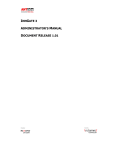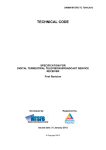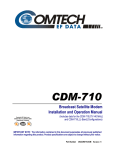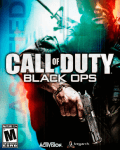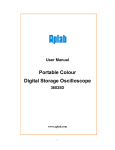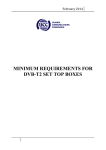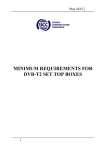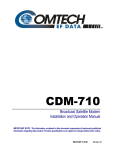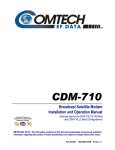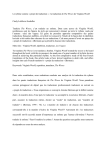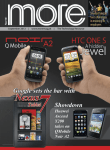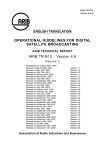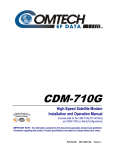Download Technical Specification for the Integrated Receiver Decoder
Transcript
DVB-T2
T2 Technical
Panel Committee
(TPC)
Telecommunications
Standards Advisory
Committee (TSAC)
2nd Generation Digital
Terrestrial Television
Broadcasting System
(DVB-T2)
Technical Specification
Integrated Receiver
Decoder (IRD)
IDA/MDA TS DVB-T2 IRD
Issue 1, November 2012
Infocomm Development Authority of Singapore
Resource Management & Standards
10 Pasir Panjang Road
#10-01 Mapletree Business City
Singapore 117438
Media Development Authority of Singapore
3 Fusionpolis Way
#16-22 Symbiosis
Singapore 138633
© Copyright of IDA/MDA, 2012
This document
ment may be downloaded from the MDA website at http://www.mda.gov.sg and
the IDA website at http://www.ida.gov.sg,
http://www.ida.gov.sg and shall not be distributed without written
permission from IDA.
IDA/MDA TS DVB-T2 IRD (November, 2012)
Acknowledgement
The Media Development Authority (MDA), the Info-communications Development Authority of
Singapore (IDA) and the Telecommunications Standards Advisory Committee (TSAC) would like to
acknowledge the following organisations represented in the MDA DVB-T2 Technical Panel Committee
(TPC) for their invaluable contributions to the formulation of the DVB-T2 basic receiver technical
specifications for Singapore:
MediaCorp Pte Ltd
StarHub Ltd
Sony EMCS (M) Sdn. Bhd.
Panasonic Singapore R&D Pte Ltd
TP Vision Singapore Pte Ltd
LG Electronics Singapore Pte Ltd
Samsung Asia Pte Ltd
SkyCom Satellite Systems Pte Ltd
List of Technical Panel Committee members
Mr Lim Chin Siang
Miss Tan Sze Siang
Miss Zoey Moh
Miss Agnes Chong
Mr Yong Seong Wei
Mr Calvin Lim
Mr Yeo Kim Pow
Mr Lau Hing Tung
Mr Roland Tan
Mr Tan Sai Yoon
Mr Peh Beng Yeow
Mr Tan Jek Thoon
Miss Ong Bee Lian
Mr Lu Jin
Mr Andrew Nai
Mr Muzaffar Fakhruddin
Miss Lee Shook Yee
Mr William Wong
Mr Philip Ong
Mr Low Kwong Wai
Mr Eric Poh
Mr Hyek Seong Kweon
Mr Leon Chew
Mr Yogesh Thalpati
Mr Sonu Mahajan
Mr Simon Tso
Mr Ben Irol
Media Development Authority
Media Development Authority
Media Development Authority
Media Development Authority
Media Development Authority
Media Development Authority
MediaCorp Pte Ltd
MediaCorp Pte Ltd
MediaCorp Pte Ltd
MediaCorp Pte Ltd
MediaCorp Pte Ltd
MediaCorp Pte Ltd
StarHub Ltd
StarHub Ltd
StarHub Ltd
Sony EMCS (M) Sdn. Bhd
Sony EMCS (M) Sdn. Bhd
Panasonic Singapore R&D Pte Ltd
Panasonic Singapore R&D Pte Ltd
TP Vision Singapore Pte Ltd
TP Vision Singapore Pte Ltd
LG Electronics Singapore Pte Ltd
LG Electronics Singapore Pte Ltd
Samsung Asia Pte Ltd
Samsung Asia Pte Ltd
SkyCom Satellite Systems Pte Ltd
SkyCom Satellite Systems Pte Ltd
Page ii
IDA/MDA TS IRD-T2 (November, 2012)
MDA and IDA would also like to acknowledge the work of the TSAC Working Group 3 (TSAC WG3) in
incorporating these recommended DVB-T2 basic receiver technical specifications into this
Specification.
IDA/MDA TS DVB-T2 IRD Issue 1,
November 2012
[Revision: 0]
Technical Specification for Integrated Digital Receiver for use
with second generation Digital Terrestrial Television
broadcasting system (DVB-T2)
TSAC WG3 Chairman
Dr Yau Wei Yun, I2R, ASTAR
TSAC WG3 Editor(s)
Ms Woo Yim Leng, IDA
Ms Tan Sze Siang, MDA
List of TSAC WG3 Members
S/N
Organisation
1
2
A*Star Institute for Infocomm Research
3
4
Above Technologies Pte Ltd
5
Advanced Digital Broadcast
6
Alcatel-Lucent Singapore
7
8
Aztech Technologies Pte Ltd
9
Creative Technology Ltd
10
Intel Technology Asia Pte Ltd
11
MediaCorp Pte Ltd
12
Media Development Authority
13
14
M1 Limited
15
Network for Electronic Transfers
(Singapore) Pte Ltd
16
Nokia Siemens Networks
17
NTT Singapore Pte Ltd
18
Nucleus Connect
19
Panasonic R&D Center Singapore
(PRDCSG)
20
PGK Media Pte Ltd
Name
Mr Lai Fon Lin
Project Manager
Dr. Shao Xu
Scientist
Dr Tham Jo Yew
Mr Poonacha Machaiah
Chairman & CEO
Mr Vincent Hendrata
Sales Director
Mr Philippe GERARD
CTO, Singapore & Brunei
Ms Ek LiLing
IPTV Solutions Architect
Mr Daniel Oh
VP of Sales
Mr Vinson Chua
Business Director, Internet Services
Mr Sanjay Rekhi
Manager, IPTV Market Development -APAC
Mr Toh Yung Shing
VP (Projects & Development)
Mr Lui Wai Leong
Analyst (Industry Policy)
Development Policy
Mr Yong Seong Wei
Analyst (Broadcast Technology)
IT & Technology
Mr Alex Tan
Director (Product Development)
Mr Johnny Chung
Principal Consultant
Ms Asha Hemrajani
Head of Global WCDMA Sales
Kiyoshi Tanaka
Senior Research Engineer
NTT Cyber Solutions Labs
Mr Poh Kwee Heng
Senior Manager
Mr Steve Ng Swee Peng
R&D Project Leader
Mr Giulio Dorrucci
Chairman & CEO
Page iii
IDA/MDA TS DVB-T2 IRD (November, 2012)
S/N
Organisation
21
Pixelmetrix Corporation
22
Reachfield IT Solutions Pte Ltd
23
Sanshin Electronics Singapore Pte Ltd
24
ServTouch WyWy (S) Pte Ltd
25
Singapore Press Holdings Ltd
26
Singapore Telecommunications Ltd
27
Sino Huawei Technologies Pte Ltd
28
StarHub Ltd
29
Sumitomo Electric Interconnect
Products (Singapore) Pte Ltd
30
31
Temasek Polytechnic
32
Thomson Video Networks
33
TTE (TCL Thomson Electronics)
34
V One Multimedia Pte Ltd
Name
Mr Danny Wilson
CEO
Mr Winson Wee Hock Soon
VP of Client Engagement and Projects
Mr Stephen Lian
Senior Sales Manager
Mr Kelvin Tan
VP
Mr Francis Ho
Systems Specialist
Mr Yeo Kian Ann
Director (Network Systems Engineering)
Mr Chan Kar Wai, Dennis
Senior Account Manager
Mr Adam Leong Kim Whye
Manager, Digital TV Master Control
Broadcast, Broadband and Cable Services
Mr Yutaka Majima
Assistant General Manager
IPTV Development
Mr Ken Usui
Manager
IPTV Marketing
Mr Yap Chern Nam
Lecturer
Mobile and Wireless Computing
Mr Vincent Volk-Leonovitch
Director of services APAC-EMEA
Dr Stan Hu Shenggang
Innovation & Technology Mgmt (CTO Office)
Mr Tan Thye Seng
CEO
Page iv
IDA/MDA TS IRD-T2 (November, 2012)
Telecommunications Standards Advisory Committee (TSAC)
The TSAC advises IDA on the setting of ICT standards as well as on the development and
recommendation of specifications, standards, information notes, guidelines and other forms of
documentation for adoption and advancement of the standardisation effort of the Singapore ICT
industry (hereafter termed “IDA Standards”).
Telecommunications standards-setting in Singapore is achieved with the assistance of TSAC, where
professional, trade and consumer interest in telecommunications standards is represented on the
TSAC with representatives from network and service operators, equipment suppliers and
manufacturers, academia and researchers, professional bodies and other government agencies.
List of TSAC Members
TSAC Chairman:
Mr Raymond Lee
Director (Resource Management & Standards)
Infocomm Development Authority of Singapore
TSAC Members:
Mr Lim Yuk Min
(TSAC Vice-Chairman)
Dr Tan Geok Leng
Mr Darwin Ho Kang Ming
Mr Yip Yew Seng
Mr Goh Kim Soon
Mr Lim Chin Siang
Ms Tan Sze Siang
Mr Patrick Scodeller
Mr Lee Wing Kai
Assoc Prof Li Kwok Hung
Assoc Prof Xiao Gaoxi
Assoc Prof Hari Krishna
Garg
Prof Ko Chi Chung
Assoc Prof Tham Chen
Khong
Mr Chong Siew Loong
Mr Tiong Onn Seng
Mr Daniel Teo
Deputy Director (Resource Management and Standards)
Infocomm Development Authority of Singapore
Acting Executive Director
Institute for Infocomm Research (I2R)
Agency for Science, Technology and Research
Vice President
Association of Telecommunications Industry of Singapore
Honorary Secretary
Association of Telecommunications Industry of Singapore
SVP (Technology Support / Technology Support, IMD)
Mediacorp Pte Ltd
Director (Interactive Digital Media Programme Office)
Media Development Authority
Deputy Director ( Digital Broadcasting Deployment Office)
Media Development Authority
Chief Technical Officer
M1 Limited
General Manager
Engineering Radio Planning
M1 Limited
Nanyang Technological University
School of Electrical & Electronic Engineering
Nanyang Technological University
School of Electrical & Electronic Engineering
National University of Singapore
Department of Electrical & Computer Engineering
National University of Singapore
Department of Electrical & Computer Engineering
National University of Singapore
Department of Electrical & Computer Engineering
Vice President (Network and Systems)
Nucleus Connect Pte Ltd
Director – Project & Operations
Opennet Pte Ltd
Director – Technical Services
Opennet Pte Ltd
Page v
IDA/MDA TS DVB-T2 IRD (November, 2012)
Mr Aw Peng Soon
Mr Huang Ee Choon
Mr Edmund Quek
Mr Lim Yong Nam
Mr Lee Yeu Ching
Mr Soh Keng Hock
Dr Wong Woon Kwong
Mrs Leong Suet Mui
Mr Tay Wei Kiang
Mr Liong Hang Chew
Ms Woo Yim Leng
Chairman of SiTF Wireless Chapter
VP, ANTLabs
Singapore Infocomm Technology Federation
Director
Communications & Information Technology
Singapore Institute of Technology
Associate Director (Radio Network Performance)
Singapore Telecommunications Ltd
Director (Voice Engineering, Next Gen IP Networks)
Singapore Telecommunications Ltd
Director (Outside Plant Engineering)
Singapore Telecommunications Ltd
Director (Private IP Engineering)
Singapore Telecommunications Ltd
Director of the Office of Research and Industry Collaborations
Singapore University of Technology and Design
Principal Technical Executive
Standards Division
Spring Singapore
Assistant Vice President
Business Solutions & Fixed Services
StarHub Integrated Network Engineering
StarHub Ltd
Assistant Vice President
Personal Solutions & Integrated Applications
StarHub Integrated Network Engineering
StarHub Ltd
Senior Manager
Infocomm Development Authority of Singapore
Page vi
Content
Section
Title
Page
Introduction
2
Part A
Basic DVB-T2 IRD Requirements
3
1.
Scope
3
2.
General Requirements
3
3.
Abbreviations
4
4.
Use of Video and Audio Coding in Broadcasting Applications
based on the MPEG-2 Transport Stream
6
5.
Frontend Characteristics
9
6.
Service Information (SI)
11
7.
Services
15
8
Interfaces and Connectors
18
9.
Firmware Operation
20
10.
References
22
Part B
Additional DVB-T2 IRD Requirements for supporting Multichannel Audio
23
Annex A
AFD Illustration for Required TV Output Display
25
Annex B
Broadcast Channel Numbers and Centre Frequencies
26
Annex C
Classification Code Matrix
27
Annex D
Basic and Digital TV Function Keys
28
Annex E
DVB-T2 Performance Requirements
29
Annex F
Proposed Logical Channel Numbering Range
31
Annex G
List of Broadcast Descriptors
32
NOTICE
THE I NFOCOMM DEVELOPMENT AUTHORITY OF SINGAPORE (“IDA”) AND T HE MEDIA DEVELOPMENT
AUTHORITY OF SINGAPORE (“MDA”) MAKE NO WARRANTY OF ANY KIND WITH REGARD TO THE MATERIAL
PROVIDED HEREIN AND EXCLUDE ANY EXPRESS OR IMPLIED WARRANTIES OR CONDITIONS OF NONINFRINGEMENT, MERCHANTABILITY, SATISFACTORY QUALITY AND FITNESS FOR A PARTICULAR PURPOSE .
SUBJECT TO THE MAXIMUM EXTENT PERMITTED UNDER LAW, IDA AND MDA SHALL NOT BE LIABLE FOR ANY
ERRORS AND/ OR OMISSIONS CONTAINED HEREIN OR FOR ANY LOSSES OR DAMAGES ( INCLUDING ANY LOSS OF
PROFITS , BUSINESS , GOODWILL OR REPUTATION, AND/OR ANY SPECIAL, INCIDENTAL OR CONSEQUENTIAL
DAMAGES ) IN CONNECTION WITH THE USE OF THIS MATERIAL.
IDA AND MDA DRAW ATTENTION TO THE POSSIBILITY THAT THE PRACTICE OR IMPLEMENTATION OF THIS
STANDARD/SPECIFICATION MAY INVOLVE THE USE OF INTELLECTUAL PROPERTY RIGHTS AND TAKE NO POSITION
CONCERNING THE EXISTENCE, VALIDITY AND/OR APPLICABILITY OF ANY SUCH INTELLECTUAL PROPERTY RIGHTS,
WHETHER ASSERTED BY TSAC MEMBERS OR ANY THIRD PARTY.
AS OF THE DATE OF APPROVAL OF THIS STANDARD, IDA AND MDA HAVE RECEIVED WRITTEN NOTICE ON PATENT
RIGHTS WHICH MAY BE RELEVANT IN RELATION TO THE IMPLEMENTATION OF THIS STANDARD/SPECIFICATION. FOR
EXAMPLE, PLEASE NOTE THAT ITEMS RELATING TO VIDEO / AUDIO CODEC, INCLUDING BUT NOT LIMITED TO MPEG,
H.264 AND E-AC3 MAY SUBJECT TO PATENT LICENSING. HOWEVER, IMPLEMENTERS ARE CAUTIONED THAT THIS
MAY NOT REPRESENT THE LATEST INFORMATION AND ARE THEREFORE STRONGLY URGED TO CHECK WITH THE
RELEVANT DATABASE IN ITU, ISO, IEC OR THE RELATED STANDARDS DEVELOPMENT ORGANISATION FOR
INFORMATION OF PATENT RIGHTS. IMPLEMENTERS ARE ADVISED TO OBTAIN THEIR OWN LEGAL AND/OR TECHNICAL
ADVICE IN RELATION TO THE IMPLEMENTATION OF THE STANDARD/SPECIFICATION IF REQUIRED.
Page 1
IDA/MDA TS DVB-T2 IRD (November 2012)
Integrated Receiver Decoder (IRD) for use with the second
generation Digital Terrestrial Television Broadcasting System
(DVB-T2)
Introduction
1.
This Specification defines the requirements for the Integrated Receiver Decoder (IRD) functionality
which may be incorporated as a standalone module such as receiver box, an Integrated Digital
Television (IDTV) or any other similar device intended for use with the second generation Digital
Terrestrial Television broadcasting system (DVB-T2). The requirements for advanced features such as
Personal Video Recorders (PVRs) and interactive services are not included in the scope of this
Specification.
2.
This Specification is established to enable equipment manufacturers and/or suppliers to bring in
compatible DVB-T2 IRD modules and IDTVs that will provide good indoor reception of Free-To-Air
(FTA) Digital Terrestrial Television (DTT) services. For the purpose of this Specification, the IRD
functioning as standalone modules or built-in modules of IDTVs shall be termed “DVB-T2 IRD”.
3.
This Specification comprises 2 parts: Part A on “Basic DVB-T2 IRD Requirements”, which specifies the
minimum requirements for using the DVB-T2 IRD with DTT networks; and Part B on “Additional DVBT2 IRD Requirements for supporting Multi-channel Audio. Part B is to be applied in addition to Part A
for DVB-T2 IRDs that are capable of supporting the multi-channel audio feature defined therein.
Page 2
IDA/MDA TS DVB-T2 IRD (November 2012)
Part A
Basic DVB-T2 IRD Requirements
1
Scope
1.1
Part A of this Specification (§ 3) defines the minimum requirements for the DVB-T2 IRD in accordance
with the implementation guidelines outlined in the DVB Specification for the use of video and audio
coding in broadcasting applications based on the MPEG-2 transport stream (ETSI TS 101 154 [1]).
The minimum functionality of the DVB-T2 IRD shall be defined by the following dimensions:
1.2
a)
25 Hz and 50 Hz;
b)
SDTV and HDTV;
c)
Input and Output interfaces;
d)
MPEG-2 and H.264/AVC video coding formats ; and
e)
MPEG-1 Layer II, E-AC3 and MPEG-4 HE AAC audio coding formats .
1
2
Part A of this Specification also requires that the DVB-T2 IRD be capable of decoding Singapore’s FTA
DVB-T and DVB-T2 broadcast of television, radio and enhanced services (§ 4). This shall include the
following capabilities:
a)
Subtitling (where available and selected by viewer);
b)
Audio Description
c)
Electronic Program Guide;
d)
Teletext;
e)
Parental Lock Feature; and
f)
Multiple Audio Selection
Note: Unless otherwise specified, all requirements are mandatory.
The word ‘’Recommended’ means this item is not mandatory but is highly recommended.
2
General Requirements
2.1
Power Supply
The DVB-T2 IRD may be AC powered or DC powered. For AC powered equipment, the Specification
shall be complied with when operating from an AC mains supply of voltage, 230V ± 10% and
frequency, 50 Hz ± 2%. Where external power supply is used, e.g. AC adaptor, it shall not affect the
capability of the equipment to meet the Specification.
2.2
Safety Requirements
The DVB-T2 IRD shall be tested for compliance with the International Electrotechnical Commission
IEC 60065 [2] safety standards.
2.3
Electromagnetic Compatibility (EMC) Requirements
The DVB-T2 IRD shall comply with §5.3, §5.6 and §5.7 of ISO/IEC CISPR13 [3] or equivalent based
on ISO/IEC CISPR 22 [4].
1
2
Please note that such coding formats may be intellectual property of third parties.
Same as Footnote 1.
Page 3
IDA/MDA TS DVB-T2 IRD (November 2012)
2.4
Identification of Equipment
The DVB-T2 IRD shall be marked with the supplier or manufacturer’s name or identification mark, and
the supplier or manufacturer’s model or type reference. The markings required shall be legible,
indelible and readily visible.
3
Abbreviations
AC
ACE
AC-3
AFC
ARC
AVC
BAT
BER
BPSK
BW
CGMS-A
CSS
CVBS
DC
DIT
DRM
DTCP
DTS
DVB-T2
DVB SI
E-AC3
EIT
ETSI
FEF
FFT
FTA
GMT
HDCP
HDMI
HE-AAC
HEM
HP
LCD
LCN
LDPC
NF
NIT
MFN
MP
MPEG
OAD
OTA
OUI
PAT
PAPR
PCM
PCR
PES
PID
PMT
PP
PLP
Alternating Current
Active Constellation Extension
Dolby Digital (5.1 Channel)
Automatic Frequency Control
Audio Return Channel
Advanced Video Coding
Bouquet Association Table
Bit Error Rate
Binary Phase Shift Keying
Bandwidth
Content Generation Management System-Analog
Content Scramble System
Composite Video Baseband Signal
Direct Current
Data Information Table
Digital Right Management
Digital Transmission Content Protection
Digital Theatre System
Digital Video Broadcasting Terrestrial Second Generation
Digital Video Broadcasting Service Information
Enhanced AC3/ Dolby Digital Plus
Event Information Table
European Telecommunications Standards Institute
Future Extension Frame
Fast Fourier Transform
Free To Air
Greenwich Mean Time
High Bandwidth Digital Content Protection
High-Definition Multimedia Interface
High Efficiency Advanced Audio Coding
High Efficiency Mode
High Profile
Logical Channel Descriptor
Logical Channel Number
Low Density Parity Check
Noise Figure
Network Information Table
Multiple Frequency Network
Main Profile
Moving Pictures Expert Group
Over Air Download
Over the Air
Organization Unique Identifiers
Program Association Table
Peak to Average Power Ratio
Pulse Code Modulation
Program Clock Reference
Packetized Elementary Stream
Program Identification Descriptor
Program Management Table
Pilot Pattern
Physical Layer Pipe
Page 4
IDA/MDA TS DVB-T2 IRD (November 2012)
PSI
PTS
QAM
QEF
QPSK
RF
SDT
SFN
SI
SIT
S/PDIF
SQB
SSI
ST
TDT
TOT
TPS
TR
TS
RST
RTC
UHF
UTC
VBI
VHF
YCbCr/YPbPr
Program Specific Information
Presentation Time Stamp
Quadrature Amplitude Modulation
Quasi Error Free
Quadrature Phase Shift Keying
Radio Frequency
Service Description Table
Single Frequency Network
Service Information
Selection Information Table
Sony/Philips Digital Interface
Signal Quality Bar
Signal Strength Indicator
Stuffing Table
Time and Date Table
Time Offset Table
Transmitter Parameter Signalling
Tone Reservation
Transport Stream
Running Status Table
Real Time Clock
Ultra-High Frequency
Universal Time Clock
Vertical Blanking Interval
Very-High Frequency
Component Video Signal
Page 5
IDA/MDA TS DVB-T2 IRD (November 2012)
4
Use of Video and Audio Coding in Broadcasting Applications based on the MPEG-2 Transport
Stream
4.1
Transport Stream Bit-streams
4.2
4.1.1
The DVB-T2 IRD shall comply with implementation guidelines outlined in § 4 of ETSI TS 101
154 [1], based on the MPEG-2 Transport Stream bit-streams requirements defined in § 2.4 of
ITU-T Rec. H.222.0 / ISO/IEC 13818-1 [5].
4.1.2
The DVB-T2 IRD shall be able to de-multiplex and present programs according to the
Program Specific Information (PSI) defined in § 2.4 of ITU-T Rec. H.222.0 / ISO/IEC 13818-1
[5].
4.1.3
The Transport Stream supports the multiplexing of video and audio compressed streams from
one program with a common time base or from multiple programs with independent time
bases. Programs are composed of one or more elementary streams, each labelled with a
Packet Identifier (PID). The DVB-T2 IRD shall be able to handle simultaneously at least 32
PIDs and elementary streams.
4.1.4
The DVB-T2 IRD shall be able to skip over data structures which are currently "reserved” (§
4.1 of ETSI TS 101 154 [1]).
4.1.5
The DVB-T2 IRD shall operate over the full tolerance range of the system clock frequency as
specified in § 2.4.2.1 of ITU-T Rec. H.222.0 / ISO/IEC 13818-1 [5].
4.1.6
The DVB-T2 IRD shall operate correctly with Program Clock References (PCRs) for a
program arriving at intervals not exceeding 100 ms as specified in § 2.7.2 of ITU-T Rec.
H.222.0 / ISO/IEC 13818-1 [5].
Video Decoding
4.2.1
The DVB-T2 IRD shall comply with the implementation guidelines outlined in § 5.1 and § 5.2
of ETSI TS 101 154 for decoding MPEG-2 video. The DVB-T2 IRD shall be able to decode
3
video formats as specified in Table 1, based on the ITU-T Rec. H.262 / ISO/IEC 13818-2 [6].
DVB-T2 IRD
25 Hz MPEG-2
SDTV
(§ 5.1 of ETSI TS
101 154)
Bit-stream
MP@ ML
Frame Rate
25 Hz interlaced
Aspect Ratio
4:3 or 16:9
Use of pan
vectors and up
sampling
Luminance Resolution
720 x 576
Capable of decoding
lower picture resolutions
Table 1: Video decoding to ITU-T Rec. H.262 / ISO/IEC 13818-2
3
Please note that such video formats may be intellectual property of third parties.
Page 6
IDA/MDA TS DVB-T2 IRD (November 2012)
4.2.2
The DVB-T2 IRD shall comply with the implementation guidelines outlined in § 5.5, § 5.6 and
§ 5.7 of ETSI TS 101 154 [1] for decoding H.264/AVC video. The DVB-T2 IRD shall be able to
decode video formats as specified in Table 2, based on the ITU-T Rec. H.264 / ISO/IEC
4
14496-10 [7].
DVB-T2 IRD
25 Hz H.264/AVC
SDTV
(§ 5.6 of ETSI TS
101 154)
Bit-stream
HP@L3
Frame Rate
25 Hz
interlaced
Aspect Ratio
4:3 or 16:9
Frame cropping
Luminance Resolution
720 x 576
Capable of decoding
lower picture
resolutions
50 Hz H.264/AVC
HDTV
With backward
compatibility
(§ 5.7 of ETSI TS
101 154)
HP@L4
50 Hz
progressive
16:9
Up sampling
1280 x 720
25 Hz H.264/AVC
HDTV
25 Hz H.264/AVC
HDTV
HP@L4
25 Hz
interlaced
25 Hz
progressive
(Optional)
16:9
Up sampling
16:9
Up sampling
1920 x 1080
HP@L4
1920 x 1080
Table 2: Video decoding to ITU-T Rec. H.264 or ISO/IEC 14496-10
4.2.3
Aspect Ratio
The DVB-T2 IRD shall provide convenient user control for appropriate aspect ratio switching
between 4:3 and 16:9 to adapt to display in different size and aspect ratio.
4.2.4
Active Format Description (AFD)
When AFD is used, the DVB-T2 IRD shall present the video aspect radio properly according to
the current AFD value and response in next frame as defined in the ETSI EN 101 154 Annex
B. The DVB-T2 IRD shall support at least the Active Formats shown in Table 3.
Refer to Annex A for the illustration on the required outputs based on the AFD values specified
in Table 3.
Active Format
1000
1001
1010
Aspect ratio of the "area of interest"
Active format is the same as the coded frame.
“Pillar box” 4:3 (centre)
“Letter box” 16:9 (centre)
Table 3: Active format (Table B.5/ETSI TS 101 154)
4
Please note that such video formats may be intellectual property of third parties.
Page 7
IDA/MDA TS DVB-T2 IRD (November 2012)
4.3
Audio Decoding
MPEG-1 Layer II Audio5
4.3.1
4.3.1.1 The DVB-T2 IRD shall comply with the implementation guidelines outlined in § 6.1 of ETSI TS
101 154 [1] for decoding MPEG-1 Layer II audio, based on ISO/IEC 13813-3 [8] in single
(mono), dual, joint stereo and stereo modes with bit rates between 64 kbit/s and 256 kbit/s,
and sampling rates of 32 kHz, 44.1 kHz and 48 kHz.
4.3.1.2 The DVB-T2 IRD shall provide convenient user control for appropriate audio output format
switching between different audio modes.
4.3.2
MPEG-4 HE AAC Version 2 Audio (Level 4)
6
The DVB-T2 IRD shall comply with the implementation guidelines outlined in § 6.4 and Annex
C5 of ETSI TS 101 154 [1] for decoding MPEG-4 HE AAC version 2 audio Level 4 and
sampling rates of up to 48 kHz, based on ISO/IEC 14496-3 [9]. The DVB-T2 IRD shall apply
bit-stream metadata parameters and down-mix multi-channel input configurations to stereo
PCM.
4.3.3
Decoding & Presentation Options for 2 Channels of Decoder Output
Codec
MPEG-1 Layer II
Analogue Output /
Speaker (IDTV)
Mono / Stereo
Optical / Coaxial
(S/PDIF) **
PCM stereo
PCM stereo
MPEG-4 HE AAC
Mono / Stereo
PCM stereo
PCM stereo
Pass through of HEAAC bit stream
Pass through of
HE-AAC bit stream
Note:
HDMI*
* Only applicable to DVB-T2 IRD with HDMI
** Only applicable to DVB-T2 IRD with S/PDIF
Table 4: Presentation Options for 2 Channels of Decoder Output
4.3.4
Audio handling when changing service or audio format
The DVB-T2 IRD should gracefully handle change of service or audio format at the audio
outputs without significant disturbances to the end user.
4.3.5
Lip-Sync
For all supported formats of audio, the maximum timing misalignment between audio and
video in reference with Program Clock Reference (PCR) - time stamp carried by Video shall
be confined within ±20 ms.
4.3.6
Loudness Matching (Optional)
The DVB-T2 IRD should apply format dependent attenuation to decoded stereo PCM audio, in
order to achieve loudness alignment between different input formats.
4.3.7
Audio Description
The DVB-T2 IRD shall support audio description in Broadcast-mix mode according to Annex E
of ETSI 101 154 [1].
5
6
Please note that such audio formats may be intellectual property of third parties.
Same as footnote 5
Page 8
IDA/MDA TS DVB-T2 IRD (November 2012)
5
Frontend Characteristics
5.1
General Considerations
The DVB-T2 IRD shall be compatible with the DVB-T baseline system according to the ETSI EN 300
744 [10] and the DVB-T2 baseline system according to the ETSI EN 302 755* [11] for digital terrestrial
TV (DTT), and able to receive DTT services in the existing VHF and UHF spectrum allocation for
analogue transmissions. It is required that the DVB-T/T2 system will provide sufficient protection
against high levels of Co-Channel Interference (CCI) and Adjacent Channel Interference (ACI)
emanating from existing PAL and digital TV services.
Note: * Support for DVB-T2 Lite is optional
Transmission Frequencies and Signal Bandwidths
Band
VHF III
UHF IV
UHF V
Frequency Range
174 – 230 MHz
470 – 606 MHz
606 – 862 MHz
Signal Bandwidth
7 MHz
8 MHz
8 MHz
Table 5: Mandatory Frequency Bands
5.2
Maximum Frequency Offset
The DVB-T2 IRD shall be able to receive signals with an offset of up to ± 1/6 MHz from the nominal
frequency.
5.3
Operating Modes
5.3.1
The DVB-T2 IRD shall be able to demodulate all non-hierarchical modes specified in the ETSI
EN 300 744 [10]. The frontend shall work compatibly with any combination of constellation
(QPSK, 16-QAM OR 64-QAM), code rate (1/2, 2/3, 3/4, 5/6 or 7/8), guard interval (TU/4, TU/8,
TU/16, or TU/32) and transmission mode (2k or 8k).
5.3.2
The DVB-T2 IRD shall be able to detect which DVB-T2 mode is being used. The DVB-T2
parameters or modes are outlined in Table 6.
Page 9
IDA/MDA TS DVB-T2 IRD (November 2012)
DVB-T2 Parameter/Mode
Constellation
Requirement
QPSK, 16-QAM, 64-QAM or 256-QAM
With or without constellation rotation
Code Rate
1/2, 3/5, 2/3, 3/4 , 4/5 or 5/6
Guard Interval
TU/128, TU/32, TU/16, TU*19/256, TU/8,
TU*19/128 or TU/4
Transmission Mode (Fast Fourier
Transform, FFT size)
1k, 2k, 4k, 8k normal, 8k extended,
16 normal, 16k extended, 32k normal or
32k extended
Pilot Pattern (PP)*
PP1, PP2, PP3, PP4, PP5, PP6 or PP7
Antenna
SISO or MISO
Peak Average Power Ratio (PAPR)
No PAPR reduction is used;
ACE-PAPR is used;
TR-PAPR is used; or
Both ACE and TR techniques are used.
Forward Error Correction (FEC)
Frame Length
64 800 bits for normal FECFRAME;
16 200 bits for short FECFRAME
Input Mode
'A' (single PLP) or 'B' (multiple PLPs)
Mode Adaptation
Normal Mode (NM); or
High Efficiency Mode (HEM)
Note: *Support for Pilot Pattern 8 is optional
Table 6: DVB-T2 Parameters/Modes
5.4
DVB-T2 Performance Requirements
The performance requirements of the DVB-T2 IRD shall be measured according to the list modes
outlined in Annex E.
5.5
Performance in Time-Varying Channels
The increase in required C/N for QEF reception shall be less than 3 dB for a 0 dB echo with frequency
separation equal to 10 Hz and a delay of 20 µs, corresponding to a Doppler shift of +/- 5 Hz (after
AFC), compared to a 0 dB echo with frequency separation equal to 1 Hz and a delay of 20 µs,
corresponding to a Doppler shift of +/- 0.5 Hz (after AFC).
5.6
Operation in Single Frequency Network (SFN)
The DVB-T2 IRD shall be able to operate in SFN with echo signals within the guard interval. When the
DVB-T2 IRD tunes to a mix of two signals from a SFN where the received signals are close in
amplitude, it is recommended that the DVB-T2 IRD selects the best signal.
Page 10
IDA/MDA TS DVB-T2 IRD (November 2012)
6
Service Information (SI)
6.1
Use of DVB Service Information (SI)
In addition to the PSI defined in § 2.4 of ITU-T Rec. H.222.0 / ISO/IEC 13818-1 [5], the DVB-T2 IRD
shall be able to decode the SI data in the Transport Stream bit-streams which provides users with
information to select services so that the DVB-T2 IRD can automatically configure itself for the
selected service. The DVB-T2 IRD shall comply with the implementation guidelines outlined in the
ETSI TR 101 211 [12] for the use of DVB SI as specified in the ETSI EN 300 468 [13]. The SI table
mechanism, syntax and semantics, and minimally, the Service Description Table (SDT), the Event
Information Table (EIT) and the Time and Date Table (TDT) shall be supported.
6.2
System Timing
The DVB-T2 IRD shall make use of Time and Date Table (TDT) for the device system time or Real
Time Clock (RTC) setting.
6.3
Optional and Unrecognised SI (Optional)
For DVB-T2 IRD with recording features, it is recommended that Selection Information Table (SIT) be
supported for partial transport stream selection and recording. Support of Bouquet Association Table
(BAT), Stuffing Table (ST) and Data Information Table (DIT) is optional. The DVB-T2 IRD shall ignore
any incomprehensive SI or tables. The DVB-T2 IRD shall discard any PSI/SI signals if it is
unrecognised or not supported.
6.4
PSI/SI and PID Update
The DVB-T2 IRD shall be able to monitor and update all PSI with shorter than 100 ms interval and all
SI with less than 1000 ms interval. The DVB-T2 IRD shall update PSI / SI information in memory
whenever any update or modification happens on a real-time basis. The DVB-T2 IRD shall take
prompt action with changes or modifications on the parameters of transmissions, networks and
services.
6.5
Dynamic Response to PAT, PMT, NIT and SDT Updates
The DVB-T2 IRD shall be capable to identify changes or new services in the current channel/multiplex.
6.6
Service Identification and Logical Channel Number (LCN)
The DVB-T2 IRD shall be able to automatically scan through the whole frequency range available for
each of the available Tuners/Demodulators and tune in to the correct DVB framing structure, channel
coding and modulation to deliver the incoming transport stream to the next units. The tuning data shall
be stored to allow a quick tune in to the selected transport stream.
The DVB-T2 IRD shall support LCN by using descriptor with tag value is 0x83 (Version 1) and 0x87
(Version 2). All services shall be sorted, listed and managed accordingly with assigned LCN. In case
duplicated and conflicted LCNs are found, shall be given to services with better signal quality, other
services shall be arranged to reserved LCN range.
The channel map shall be from 1-999 with valid LCN’s is being assigned in the range from 1-799 by
the broadcaster (Contain all types of services including Radio/Data/Video). The LCN reserved range is
set from 800 – 999.
The assigned private data specifier is “0x00000019’’.
Broadcaster will be assigned with the logical channel numbering (LCN) range for terrestrial FTA
channels to facilitate easy access to these channels. For example, by pressing ‘2’ on remote control
will allow user to switch to Channel 5, ‘3’ to switch to Channel 8 (See Annex F for the proposed
Channel Numbering Range for FTA channels.)
Page 11
IDA/MDA TS DVB-T2 IRD (November 2012)
6.6.1
Logical Channel Numbering (LCN)
The intention of the LCN service information is to provide a broadcaster assigned virtual
channel number or label, for each of the available DTV services to the DVB-T2 IRD, so the
DVB-T2 IRD is able to easily facilitate the channel sorting, indexing, ordering, and searching.
The LCN descriptor also defines visibility of the service to the viewer.
The syntax and semantics of the logical_channel_descriptor is indicated in Table 7 below, as
follows:
Syntax
logical_channel_descriptor(){
descriptor_tag
descriptor_length
for (i=0;i<N;i++){
service_id
visible_service3_flag
reserved
logical_channel_number
}}
Bits
Identifier
8
8
uimsbf
uimsbf
16
1
5
10
uimsbf
bslbf
bslbf
uimsbf
Table 7: Syntax and Semantics of the Logical Channel Descriptor
descriptor_tag: This shall be assigned to be 0x83.
service_id: This is a 16-bit field which serves as a label to identify this service from any other
service within the Transport Stream. The service_id is the same as the program_number in the
corresponding program_map_section. Services shall be included irrespective of their running
status.
visible_service_flag:
= 1:
The service is visible and selectable via the DVB-T2 IRD service list.
= 0:
The service is invisible and not selectable via the DVB-T2 IRD service list, however
the DVB-T2 IRD may provide a mechanism to access these services.
reserved: This 5-bit field is reserved for future use, shall be set to “1”.
logical_channel_number: This is a 10-bit field which indicates the broadcaster preference for
ordering service.
The channel map shall be from 1-999. A broadcaster may or may NOT allocate more than one
Logical Channel Number to a service. This is to avoid multiple LCN assignment which could
lead to cross reference and confusion.
Page 12
IDA/MDA TS DVB-T2 IRD (November 2012)
6.6.2
Logical Channel Descriptor (Version 2)
The syntax of the Logical Channel Descriptor (version 2) is shown in below Table 8.
Syntax
No. of
bits
Identifier
descriptor_tag
8
8
8
Uimsbf
Uimsbf
Uimsbf
descriptor_length for
(i=0;i<N;i++){
channel_list_id
8
Uimsbf
8
Uimsbf
Uimsbf
Uimsbf
Uimsbf
Bslbf
Bslbf
Uimsbf
Logical_channel_descriptor(){
channel_list_name_length
for (i=0;i<N;i++) {
char
}
country_code
descriptor_length
for (i=0;i<number_of_services;i++){
service_id
24
8
16
1
5
visible_service_flag
10
reserved_future_use
logical_channel_number
}
}
}
Table 8: Syntax and Semantics of the Logical Channel Descriptor (Version 2)
descriptor_tag: This shall be assigned to be 0x87 (decimal 135).
channel_list_id: This is an 8-bit field which serves as a label to identify the channel list
(uniquely allocated within each original_network_id). The user should be able to select a
preferred channel list to be used, when several are available during the first-time installation
(or complete re-installation).
channel_list_name_length: This 8-bit field specifies the number of bytes that follow the
channel_list_name_length field for describing characters of the name of the Channel List.
Maximal length is 23 bytes for the channel_list_name.
char: This is an 8-bit field. A string of character fields specify the name of the channel list, the
channel_list_name. (Maximal length is 23 bytes for the channel_list_name). Text information is
coded using the character sets and methods described in EN 300 468.
country_code: This 24-bit field identifies a country using the 3-character code as specified in
ISO/IEC 3166 [14]. Each character is coded into 8-bits according to ISO/IEC 8859-1[15] and
inserted in order into the 24-bit field. This shall be set to “SGP”.
service_id: A service_id that belongs to the TS (i.e. services from other TS shall not be
listed). One service may only be listed once in each channel list, but may belong to/be listed in
more than one channel list.
visible_service_flag: This 1-bit field when set to ‘1 ’/’true’ indicates that the service is
normally visible and selectable (subject to the service type being suitable etc.) via the DVB-T2
IRD’s service list. When set to ‘0’/’false’ this indicates that the DVB-T2 IRD is not expected to
offer the service to the user in normal navigation modes however the DVB-T2 IRD should
provide a mechanism to access these services (for example by direct entry of the logical
Page 13
IDA/MDA TS DVB-T2 IRD (November 2012)
channel number).
Reserved: All “reserved” bits shall be set to ’1’ (observe, however, that the DVB-T2 IRD shall
be able to handle (neglect) future use of reserved bits).
logic_channel_number: The channel map shall be from 1-999 with valid LCN’s is being
assigned in the range from 1-799 by the broadcaster (Contain all types of services including
Radio/Data/Video).
6.6.3
Logical Channel Descriptor Simultaneous Version 1 and Version 2 Transmissions
When both Logical Channel Descriptor version 1 and version 2 are broadcasted within one
Original Network ID, the DVB-T2 IRD supporting both descriptors shall only sort according to
the version 2 (higher priority).
6.6.4
Listing of Broadcast Descriptors
The list of broadcast descriptors is attached in Annex G.
Page 14
IDA/MDA TS DVB-T2 IRD (November 2012)
7
Services
7.1
Subtitling
7.1.1
Specification for Subtitling
The DVB-T2 IRD shall support DVB subtitling in accordance with ETSI EN 300 743 [16], and
displayed using the On Screen Display (OSD) capabilities while decoding the full television
service (video and audio). The subtitle object code shall be handled as pixels (bitmap).
7.1.2
Multiple Subtitling Language
The DVB-T2 IRD shall be able to handle multiple subtitling streams within the same service
and the correspondent PSI/SI information like languages descriptors.
The receiver shall provide convenient user control for enabling, disabling displaying and to
select primary and secondary subtitling languages.
In case of subtitling is set to “ON” and the subtitle streams do not match any of the settings of
preferred languages, the receiver shall select the first subtitle stream signaled in the
elementary stream loop of the PMT.
The recommended factory default setting:
The default setting on the receiver for subtitling set to “ON”
The primary preferred language set to “Multiple Languages” (MUL)
The secondary preferred language set to “Multiple Languages” (MUL)
7.1.3
Support for hearing impaired
The DVB-T2 IRD shall have user selection of subtitling preferences for ‘normal’ or ‘hard of
hearing’ subtitles.
In case of ‘hard of hearing’ subtitling mode is selected and if no ‘hard of hearing’/‘hearing
impaired’ pages are received (signalised in subtitling descriptor and/or teletext descriptor),
then the receiver shall as a default use ‘normal’ subtitling pages from the same selected
language.
7.2
Electronic Program Guide (EPG)
7.2.1
Specification for EPG
The DVB-T2 IRD shall decode full EIT information with capability to display “present /
following” (or “Now / Next”) and schedule EPG information in accordance with guidelines given
in ETSI TR 101 211 [12] and requirements defined in ETSI EN 300 468 [13].
The receiver shall also be able to continue to operate in the absence of EIT transmission.
7.2.2
EPG Presentation
EPG presentation shall include but not limited to the followings:
a)
b)
c)
d)
e)
f)
g)
service name
program title
program duration
elapsed duration (optional)
short description
long description (extended text)
present / following (now / next) event
Page 15
IDA/MDA TS DVB-T2 IRD (November 2012)
h) current date/time
i) parental guidance information
The receiver shall provide an EPG organizer to access Next seven-day program guide with all
information in above list. It should be a practical and easy to use search function.
7.2.3
Languages and Fonts
For EPG and other labeling decoding and presentation, the receiver shall support the
character coding tables specified in below table:
Font
Latin
Chinese
Tamil
(Optional)
Coded Character Set
ISO 6937
GB18030-2005
Unicode range U+0B80-U+0BFF
First byte value
N/A
0x11 and 0x15
0x11 and 0x15
Note:
a)
b)
7.2.4
The first byte value is signalled according to ETSI EN 300 468 Annex A [13].
GB18030-2005 characters are broadcasted as ISO 10646 UTF-16 or UTF-8 code points. The receiver is
not required to support code points beyond the Basic Multilingual Plane.
Parental Lock Feature
The DVB-T2 IRD shall have parental lock capabilities to block television program with a
particular Classification Code from being shown unless the correct personal identification
number (PIN) code is entered by the user.
The DVB-T2 IRD must be able to identify the Classification Code that is applied to the
television program and shall allow user to set the rating that he/she wants to block.
The matrix table which shows the list of Classification Code and their assigned hexadecimal
code is attached in Annex C.
The Classification Codes are defined as follows:
a) General (G) – Suitable for all ages;
b) Parental Guidance (PG) – Suitable for all, but parents should guide their young;
c) Parental Guidance 13 (PG13) – Suitable for persons aged 13 and above but parental
guidance is advised for children below 13;
d) No Children Under 16 (NC16) – Suitable for persons aged 16 and above;
e) Mature 18 (M18) – Suitable for persons aged 18 and above; and
f) Restricted 21 (R21) – Restricted to persons aged 21 and above.
7.2.5
Parental Rating Display
The parental rating information shall be displayed clearly as part of EPG.
The parental rating descriptor shall be transmitted and the full parental rating information shall
be appended to the front of the program title or program description by the broadcaster.
Manufacturers can add additional displays of programme ratings, but they must display the full
rating information.
7.3
Multi-Language Support
The DVB-T2 IRD shall provide a mechanism for the selection of primary and secondary language
options for both Subtitles and Audio selection. The receiver shall as a minimum, interpret the language
codes outlined in the table below.
Page 16
IDA/MDA TS DVB-T2 IRD (November 2012)
Language
English
Chinese
Bahasa Melayu
Tamil
Original Audio
Multiple Languages
ISO 639-3 Code
ENG
ZHO
MSA
TAM
QAA*
MUL**
* Original Audio is only applicable for Audio
** Multiple Languages is only applicable for Subtitle
7.4
Teletext
The DVB-T2 IRD shall be able to demultiplex in parallel the Teletext service transmitted in a
packetised format according ETSI EN 300 472 [17]. The DVB-T2 IRD shall be able to display Teletext
service, meeting the requirements for at least Level 1.5 in ETSI EN 300 706 [18] - Enhanced Teletext
specification.
7.5
Remote Control Interface
A Remote Control shall be bundled with the DVB-T2 IRD. It should be simple and easy to use. Basic
functionality such as power, volume control and numerical number 0-9 shall be placed on prominent
locations on the remote control. Colour-coded multifunctional buttons shall be included to enhance
user experience and ease the navigation on the receivers.
The list of basic and digital TV function keys is attached in Annex D.
Page 17
IDA/MDA TS DVB-T2 IRD (November 2012)
8
Interfaces and Connectors
8.1
RF Input Connector
The DVB-T2 IRD shall have one input tuner connector, type: IEC female in accordance with IEC
60169-2, part 2 [19]. The input impedance shall be 75 ohm.
8.2
RF Output Connector
The DVB-T2 IRD without an integrated display should provide a connector with a loop-through of input
RF signal.
a) The connector shall be of type: IEC male in accordance with IEC 60169, part 2 [19].
b) The frequency range for the RF loop-through should be from 47 MHz to 862 MHz.
c) The RF loop-through signal shall be present independently from the status of the DVB-T2 IRD
device (operational or standby), such that that connected equipment (e.g. TV set) can operate
even if the device is in standby mode.
d) When the RF bypass gain is disabled, the maximum RF bypass gain should -4dB and when
the RF bypass gain is enabled, the RF bypass gain should be from –1 dB to +3 dB.
8.3
Modulator output (Optional)
The DVB-T2 IRD without an integrated display should provide a re-modulated output for use with a
PAL receiver. If so, the output must be tuneable to any of UHF channels 21 to 68. The peak signal
level should be 3 mV nominal across 75 ohm (-39 dBm).
8.4
Antenna Output Power (Optional)
It is optional for the receiver to provide 5V DC output for the active antenna power supply. If it is
provided, the 5V DC shall be able to be turned on/off.
8.5
Component Analogue Outputs (Optional)
It is optional for the receiver to provide component analogue output (YPbPr).
8.6
Composite Video Outputs
For DVB-T2 IRD (standalone module) the composite video output shall comply with PAL Connector
IEC 48B Section 316 (RCA- phono).
8.7
Additional Requirements for Composite Video Interface
For the analogue outputs, the DVB-T2 IRD (standalone module) shall also support insertion of the
teletext data in the VBI of the analogue CVBS video output. In this case the teletext decoder of the TVset might be used instead of the one in the receiver. The VBI insertion shall be compliant with ITU-R
BT.653-3 [20]. The Teletext data shall be inserted in the lines 7 to 22 and lines 320 to 335.
8.8
Analogue Audio
The DVB-T2 IRD (standalone module) shall provide RCA-phono output interface for analogue stereo
audio.
8.9
Digital Audio Data Stream Output (Optional)
It is optional for the DVB-T2 IRD to provide an S/PDIF digital audio output – electrical (coaxial) or
optical (TOSLINK). The capabilities of this interface are defined in section 4 of this document.
Page 18
IDA/MDA TS DVB-T2 IRD (November 2012)
8.10 HDMI
7
The DVB-T2 IRD (standalone module) shall provide HDMI interface for digital video and audio output.
8.11 Copy Protection on Outputs
The DVB-T2 IRD (standalone module) shall provide High Bandwidth Digital Content Protection
(HDCP) on the HDMI output for all output resolutions.
8.12 Common Interface (Optional)
The DVB-T2 IRD may incorporate a DVB-CI (Common Interface) slot. If available this slot shall be a
certified CI+ slot as outlined in CI+ specification V1.3 meeting all the required robustness rules.
7
Please note that such multimedia interface for transferring data may have intellectual property of third parties.
Page 19
IDA/MDA TS DVB-T2 IRD (November 2012)
9
Firmware Operation
9.1
Operating System and Memory
The DVB-T2 IRD shall have an embedded real time operating system. It shall include a non-volatile
memory for retaining user settings and other data.
9.2
First-time Power Up
Upon powering up for the first-time, the DVB-T2 IRD shall initiate the following process:
a) Set OSD language (Default – English);
b) Set active antenna power [if available] ( Default – Off,);
c) Prompt tuning/scanning for all available FTA services; and
d) Set other configurations (user data, preferences, etc).
9.3
Initial Channel Scan
The tuning/ scan process should be manually initiated to prevent scanning before the antenna is
connected.
The DVB-T2 IRD shall do a full scan of all available services in all the TV broadcast bands starting
with VHF TV Band III to UHF Band. The DVB-T2 IRD’s scan process shall include all possible
combinations of OFDM parameters until the transmission parameters are found.
9.4
Subsequent Power On
The DVB-T2 IRD shall return either to last watched or preset start-up service.
9.5
Listing of all available services
The DVB-T2 IRD shall provide a listing of all available FTA services after scanning.
9.6
Responses to Network Changes
9.6.1
Addition of multiplex on a network
When a multiplex is added to the network, it shall make reference in the second loop of the
NIT actual table. The NIT (actual) and SDT (actual and other) version_number shall be
changed. The DVB-T2 IRD shall recognise the change of version_number of the NIT table and
that a new transport_stream_id is present in the NIT (actual).
9.6.2
Addition or removal of service on a multiplex
When a service has been added to a multiplex, there shall be an update in the SDT (actual)
for that multiplex which references the new service.
The DVB-T2 IRD shall consider a service to be removed from a multiplex if the service is not
referenced in the SDT (actual) of that particular service.
A rescan of any or all the terrestrial multiplexes shall not be required for the DVB-T2 IRD to
acknowledge the presence of a new service. The DVB-T2 IRD shall process the SDT (actual)
and EIT-present/following (actual) when tuning to a different multiplex or every 2 seconds as
recommended by ETSI TR 101 211 [12].
When a new service is added or removed from a multiplex, the DVB-T2 IRD may inform the
user that a new service has been added or removed using an appropriate DVB-T2 IRD
specific method e.g. a short screen pop-up lasting not more than 3 seconds.
Page 20
IDA/MDA TS DVB-T2 IRD (November 2012)
9.6.3
Transmission mode change
In the event that there is any transmission mode changes, the DVB-T2 IRD shall automatically
perform update to capture these changes without disruption to the viewer.
9.6.4
Clash resolution
The DVB-T2 IRD shall base on the PDS (Private Data Specifier) before assigning LCN to the
services and put other services (if any) with the same LCN from undefined PDS to ‘reserved’
LCN range.
9.7
Signal strength and quality bar
The DVB-T2 IRD shall be able to display both signal strength and quality (BER) level. This will aid the
user in setting up indoor antenna to ensure best reception position or identifying other reception
problems.
9.8
Service unavailability
In the event of service unavailable, poor or no RF signal, the DVB-T2 IRD shall display an on-screen
message.
9.9
Hardware reset / reboot / factory default setting
The DVB-T2 IRD shall support hot reset, cold reset, and a full reset to manufacturer’s default start-up
settings.
9.10 Channel zapping time
The channel zapping time between channels within same multiplex shall be between 1.5 to 2 seconds.
It shall be met for a GOP length of 12, and a repetition rate of PAT and PMT of 10 tables per second.
Interruption to viewer during channel zapping shall be kept at minimal.
9.11 System software update (SSU/OTA/OAD)
The DVB-T2 IRD shall be able to support Over-The-Air firmware upgrade by using System Software
Update mechanism in accordance with standard of ISO/IEC 13818-1 [5], ETSI TS 101 154 [1] and
ETSI TS 102 006 [21]. The DVB-T2 IRD shall automatically detect and invoke OTA (SSU) service by
recognized Organization Unique Identifiers (OUI) in the NIT linkage with type value as 0x9. The DVBT2 IRD shall at least support DVB-SSU simple profile.
The default DVB-SSU mode for DVB-T2 IRDs shall be with DVB-SSU “enabled”.
9.12 User system software upgrade
The DVB-T2 IRD shall provide one or more of the following data interfaces to enable the user to
perform software upgrades.
a) Universal Serial Bus (USB)
b) RJ 45 (Ethernet IEE802.3)
c) Appropriate Memory Card
Page 21
IDA/MDA TS DVB-T2 IRD (November 2012)
10
References
[1]
ETSI TS 101 154 v1.10.1 (2011-06) Digital Video Broadcasting (DVB); Specification for
the use of Video and Audio Coding in Broadcasting Applications based on the MPEG-2
Transport Stream
[2]
IEC 60065 (Feb 2011) Audio, video and similar electronic apparatus – Safety
requirements
[3]
IEC CISPR 13 (Jun 2009) Sound and television broadcast receivers and associated
equipment – Radio disturbance characteristics – Limits and methods of measurement
[4]
IEC CISPR 22 (Sept 2008) Information Technology equipment – Radio disturbance
characteristics – Limits and methods of measurement
[5]
ITU-T Rec. H.222.0 / ISO/IEC 13818-1 (2012), Information technology – Generic coding
of moving pictures and associated audio information: Systems
[6]
ITU-T Rec. H.262 / ISO/IEC 13818-2 (2012), Information technology – Generic coding of
moving pictures and associated audio information: Video
[7]
ITU-T Rec. H.264 / ISO/IEC 14496-10 (01/2012), Infrastructure of audiovisual services –
Coding of moving video: Advanced video coding for generic audiovisual services
[8]
ISO/IEC 13818-3 (Apr 1998) Information technology — Generic coding of moving
pictures and associated audio information- Part 3: Audio
[9]
ISO/IEC 14496-3 (Sep 2009) Information technology — Coding of audio-visual objects
—Part 3: Audio
[10]
ETSI EN 300 744 v1.6.1 (2009-01) Digital Video Broadcasting (DVB); Framing structure,
channel coding and modulation for digital terrestrial television
[11]
ETSI EN 302 755 v1.3.1 (2012-04) Frame structure channel coding and modulation for
a second generation digital terrestrial television broadcasting system (DVB-T2)
[12]
ETSI TR 101 211 v1.9.1 (2009-06) Digital Video Broadcasting (DVB) Guidelines on
implementation and usage of Service Information (SI)
[13]
ETSI EN 300 468 v1.13.1 (2012-04) Digital Video Broadcasting (DVB); Specification for
Service Information (SI) in DVB systems
[14]
ISO/IEC 3166-1 Countries and Subdivisions Codes (2006)
[15]
ISO/IEC 8859 Information technology — 8-bit single-byte coded graphic character sets
(1998)
[16]
ETSI EN 300 743 v1.4.1 (2011-10) Digital Video Broadcasting (DVB); Subtitling systems
[17]
ETSI EN 300 472 v1.3.1 (2003-05) Digital Video Broadcasting (DVB); Specification for
Conveying ITU-R System B Teletext in DVB bitstreams
[18]
ETSI EN 300 706 v1.2.1 (2003-04) Digital Video Broadcasting (DVB); Enhanced
Teletext Specification
[19]
IEC 60169-2 (1995) Radio-frequency connectors, Part 2: Coaxial unmatched connectors
[20]
ITU-R Rec. BT.653-3 (02/1998) Teletext systems
[21]
ETSI TS 102 006 v1.3.2 (2008-07) Digital Video Broadcasting (DVB); Specification for
System Software Update in DVB Systems
[22]
ETSI TS 102 366 v1.2.1 (2008-8) Digital Audio Compression (AC3, Enhanced AC3)
Standard
Page 22
IDA/MDA TS DVB-T2 IRD (November 2012)
Part B
Additional DVB-T2 IRD Requirements for supporting Multichannel Audio
Multi-channel Audio
1
Format
The DVB-T2 IRD shall identify, accept and decode input bit-streams in the following formats:
2
8
a)
E-AC3 as specified in ETSI TS 102 366 [22]; and
b)
MPEG-4 HE AAC version 2 Level 4 as defined in ISO/IEC 14496-39 [9]
Metadata
The DVB-T2 IRD shall apply bit-stream metadata parameters and down mix multi-channel input
configurations to stereo PCM for Enhanced AC-3 in accordance with guidelines given in ETSI TS
102 366 [-20] and MPEG-4 HE AAC as specified in ISO/IEC14496-3 [9] and ETSI TS 101 154 [1].
3
Pass-through
The DVB-T2 IRD shall pass through the native audio elementary input bit-stream over the HDMI
output for standalone module or ARC output for DVB-T2 IRD (where applicable) as well as the
optical/coaxial output (where applicable).
4
Trans-coding
The DVB-T2 IRD shall trans-code audio and metadata from E-AC3 input bit-streams to AC-3 output
bit-streams at a data rate of 640kbps. The DVB-T2 IRD shall transcode audio and metadata from
MPEG-4 HE AAC input bit-streams to an AC-3 output bit-stream at a data rate of 640kbps or
alternatively to a DTS output bit stream at a data rate of 1.5 Mbps. The number of channels on the
output AC-3 or DTS bit-stream shall be equal to or greater than the number of channels contained
within the input bit-stream. The AC-3 or DTS bit-stream shall be provided over the following outputs:
8
9
a)
S/PDIF; and
b)
HDMI output for standalone module or ARC output for DVB-T2 IRD (where applicable).
Please note that such audio formats may be intellectual property of third parties.
Same as footnote 8
Page 23
IDA/MDA TS DVB-T2 IRD (November 2012)
5
Decoding & Presentation Options for Multi-Channel Decoder
Codec
Analogue Output /
Speaker (IDTV)
Optical / Coaxial
(S/PDIF) **
HDMI*
E-AC3
multi-channel
Down-Mixed Stereo
Trans-code to AC-3 bitstream and pass
through
Pass through of E -AC3
bit-stream
PCM stereo
Trans-code to AC-3 bitstream and pass through
PCM stereo and multichannel
MPEG-4 HE AAC
multi-channel
Down-Mixed Stereo
Trans-code to AC-3 or
DTS bit-stream and
pass through
PCM stereo
Pass through of HEAAC bit stream
Note:
Pass through of HE-AAC
bit-stream
Trans-code to AC-3 or
DTS bit-stream and pass
through
PCM stereo and multichannel
* Only applicable to DVB-T2 IRD with HDMI
** Only applicable to DVB-T2 IRD with S/PDIF
Table 9: Presentation Options for Multi-Channel Decoder
6
Audio Description
The DVB-T2 IRD shall support audio description in Receiver-mix mode according to Annex E of ETSI
101 154 [1].
Page 24
IDA/MDA TS DVB-T2 IRD (November 2012)
Annex A
AFD Illustration for Required TV Output Display
The illustration below is the required outputs based on the AFD values specified in Table 3 of
section 4.2.4.
Page 25
IDA/MDA TS DVB-T2 IRD (November 2012)
Annex B
Broadcast Channel Numbers and Centre Frequencies
Bandwidth
(MHz)
Channel
Number
Centre
Frequency
(MHz)
TV
BAND
III
7
TV
BAND
IV
8
5
6
7
8
9
10
11
12
21
22
23
24
25
26
27
28
29
30
31
32
33
34
35
36
37
177.5
184.5
191.5
198.5
205.5
212.5
219.5
226.5
474
482
490
498
506
514
522
530
538
546
554
562
570
578
586
594
602
TV
BAND
V
Page 26
Bandwidth
(MHz)
Channel
Number
Centre
Frequency
(MHz)
8
38
39
40
41
42
43
44
45
46
47
48
49
50
51
52
53
54
55
56
57
58
59
60
61
62
63
64
65
66
67
68
69
610
618
626
634
642
650
658
666
674
682
690
698
706
714
722
730
738
746
754
762
770
778
786
794
802
810
818
826
834
842
850
858
IDA/MDA TS DVB-T2 IRD (November 2012)
Annex C
Classification Code Matrix
The EIT will carry DVB parental_rating_descriptor (with the tag of 0x55 as outlined in EN 300 468 [13])
alongside with the country code “SGP”. The rating value (parental rating code) carried by this descriptor is
associated with the matrix table shown below for on-screen display and channel block.
Where the broadcasted rating value is not classified (grey area), the DVB-T2 IRD shall interpret the
rating to be the next higher classification. Example: If 0x05 is transmitted, it shall be treated as 0x07
(PG13). (By choosing a higher classification, it gives better protection in case the intent is to transmit a
higher classification.)
Grey fill area are reserved for future use. (E.g. New classification/rating in future will be fitted into the
grey area.)
Reference to the above Yellow Box:
The column “Parental Rating Code” (Hex code) is transmitted together with the television program.
DVB-T2 IRD should be able to identify the assigned hex code according to the classification code.
Example: When user selects to block PG13, programs with classification Undefined, General (G) and
Parental Guidance (PG) are allowed to display on screen while programs with classification PG13,
NC16, M18 and R21 are blocked from viewing until the user entered the pin to unblock the program.
Page 27
IDA/MDA TS DVB-T2 IRD (November 2012)
Annex D
Basic and Digital TV Function Keys
The DVB-T2 IRD’s remote control shall include the following keys for basic TV functionality or equivalent:
a) Power on/off [on/off] – turn the DVB-T2 IRD on and off
b) Program up/down [P+, P-] – switch between programs
c) Volume up/down [V+, V-] – adjust the volume output level
d) Subtitle/option [Subt/option] – display the subtitle or select other user selectable options (e.g. change
subtitling language if several available, audio language/track if several available, video aspect ratio
output format etc.)
e) Info [Info] – display additional information if available
The DVB-T2 IRD’s remote control shall include the following keys for digital TV functions or equivalent:
a) A navigation or pointing system for navigation on the OSD
b) OK [OK] – a function that selects or confirms current choice or statement
c) Multifunctional keys – four color-coded keys for non-dedicated functions. The colors shall be red,
green, yellow and blue.
d) Text [Text] – This function displays the Teletext as defined in this Specification.
e) Guide/EPG [Guide] – This function displays an Electronic Program Guide.
Page 28
IDA/MDA TS DVB-T2 IRD (November 2012)
Annex E
DVB-T2 Performance Requirements
Identifier
SG1
SG2
SG3
SG4
SG5
Purpose
Fixed
Outdoor
Reception
Indoor
Reception
Indoor
Reception
Indoor
Reception
Indoor
Reception
Overall
FFTSize
32K
16K
16K
16K
16K
GI
1/32
1/16
1/16
1/16
1/16
SISO/MISO
SISO
SISO
SISO
SISO
SISO
TR
TR
TR
TR
TR
PAPR
8MHz
8MHz
8MHz
8MHz
8MHz
Carrier Mode
Extended
Extended
Extended
Extended
Extended
Pilot Pattern
PP4
PP2
PP2
PP2
PP2
BPSK
BPSK
BPSK
BPSK
BPSK
Data Symbols per Frame (Ldata)
61
130
130
130
130
OFDM Symbols per Frame (Lf)
62
131
131
131
131
Frame Duration (ms)
229
250
250
250
250
2
2
2
2
2
PLP Type
1
1
1
1
1
Time Interleaver Type (TIME_IL_Type)
0
0
0
0
0
256 QAM
64QAM
64QAM
64QAM
256QAM
Bandwidth
L1 Modulation
Frames Per SuperFrame
PLP Parameter
Modulation
2/3
3/5
2/3
3/4
3/5
Normal
(64k)
Normal
(64k)
Normal
(64k)
Normal
(64k)
Normal
(64k)
No
No
No
No
No
200
151
151
151
202
TI blocks per frame (N_TI)
3
3
3
3
3
Frame_Interval (I_JUMP)
1
1
1
1
1
Approx. Time Interleaving Length (ms)
78
84
84
84
84
Rate
FEC Type
Rotated QAM
FEC blocks per interleaving Frame
Full channel (Trial mode)
Approx. Channel Data Rate (Mbit/s)
Performance assuming implementation
losses is 2dB for PP2 and 1.5dB for PP4
C/N Performance on Gaussian channel
(dB)
C/N performance on 0dB echo channel
(dB)
Minimum receiver signal input levels on
Gaussian channel (dBm)
Minimum IRD Signal Input Levels on 0dB
echo channel (dBm)
Receiver noise figure on Gaussian
channel
Maximum Receiver Signal Input Levels
(dBm)
37.66
23.48
26.12
29.39
31.41
8MHz UHF
Band IV &
V
8MHz UHF
Band IV &
V
8MHz UHF
Band IV &
V
8MHz UHF
Band IV &
V
8MHz UHF
Band IV &
V
20.4
14.8
16.2
17.7
19.4
24.6
18.0
19.7
22.0
23.1
-78.7
-84.3
-82.9
-81.4
-79.7
-74.5
-81.1
-79.4
-77.1
-76.0
6.0
6.0
6.0
6.0
6.0
-35
-35
-35
-35
-35
-28
-34
-32
-31
-28
Immunity to “digital” signals in Other Channels
Digital ACI N+/-1 C/I (dB)
Page 29
IDA/MDA TS DVB-T2 IRD (November 2012)
Digital ACI N+/-2 C/I (dB)
-38
-44
-42
-41
-38
Digital ACI N+9 C/I (dB)
-28
-34
-32
-31
-28
1
4
3
Immunity to Co-Channel Interference From Analogue TV Signals
PAL B/G CCI C/I (dB)
5
-3
Immunity to Adjacent Channel Interference From Analogue TV Signals
PAL B/G ACI C/I N+/-1 (dB)
-33
-39
-37
-36
-33
PAL B/G ACI C/I N+/-2 (dB)
-44
-50
-48
-47
-44
PAL B/G ACI C/I N+9 (dB)
Performance in Time-Varying Channels
10Hz doppler (5Hz after AFC) 20us 0dB
echo
Synchronisation for varying echo power
levels in SFN (dB)
C/(N+I) Performance in Single Frequency
Networks for more than one echo (dB)
C/(N+I) Performance in Single Frequency
Networks inside the guard interval (dB)
-44
-50
-48
-47
-44
3dB
3dB
3dB
3dB
3dB
28.1
21.0
22.7
25.0
26.1
24.6
18.0
19.7
22.0
23.1
24.6
18.0
19.7
22.0
23.1
Echo level
dBc
Echo level
dBc
C/(N+I) Performance in Single Frequency Networks outside the guard interval (dB)
Echo level Echo level Echo level
Delay us
dBc
dBc
dBc
-266
-12
-9
-10
-12
-13
-230
-11
-8
-9
-11
-12
-200
-10
-7
-8
-9
-11
-150
-6
-3
-4
-6
-8
-120
-2
-2
-2
-2
-2
120
-2
-2
-2
-2
-2
150
-6
-3
-4
-6
-8
200
-10
-7
-8
-9
-11
230
-11
-8
-9
-11
-12
266
-12
-9
-10
-12
-13
Note: The performance requirement is based on 30 seconds error free video.
Page 30
IDA/MDA TS DVB-T2 IRD (November 2012)
Annex F
Proposed Logical Channel Numbering (LCN) Range
MediaCorp’s Free to Air (FTA ) channel numbering on terrestrial platform
LCN
Channel
1
Preview Channel (Define as Reserved)
2
Channel 5
3
Channel 8
4
Suria
5
Vasantham
6
Channel News Asia
7
Channel U
8
Okto
Page 31
IDA/MDA TS DVB-T2 IRD (November 2012)
Annex G
List of Broadcast Descriptors
Descriptors in use (exclude data
broadcasting)
Tag
NIT
0x40
*
0x5A
0x7F/0x04
(ext)
*
*
service_list_descriptor
0x48
*
logical_channel_descriptor
0x83
*
private_data_specifier_descriptor
0x5F
*
service_descriptor
0x41
*
multilingual_service_name_descriptor
0x5D
*
component_descriptor
0x50
*
short_event_descriptor
0x4D
*
extended_event_descriptor
0x4E
*
local_time_offset_descriptor
0x58
iso_639_language_descriptor
0x0A
*
stream_identifier_descriptor
0x52
*
AC-3 descriptor
0x6A
*
subtitling_descriptor
0x59
*
teletext_descriptor
0x56
*
video_stream_descriptor
0x02
*
audio_stream_descriptor
0x03
*
content_descriptor
0x54
*
parental_rating_descriptor
0x55
*
Enhanced_AC-3 descriptor
0x7A
*
AAC_descriptor
0x7C
*
network_name_descriptor
terrestrial_delivery_system_descriptor
T2_delivery_system_descriptor
Descriptors required for SSU
SDT
EIT
TOT
PMT
*
Tag
NIT
linkage_descriptor
0x4A
*
Data_broadcast_id_descriptor
0x66
SDT
EIT
TOT
PMT
*
Note: The list is not exhaustive; it shows the typical descriptors that may be broadcast by terrestrial
broadcasters.
Page 32







































